Wednesday 13 February 2019
Turners Point, Norfolk Bay

Refreshed from our previous day’s rest, we made our exit from the marina at the appointed time of 9:30am. After untying the lines, it was then a case of backing out carefully, then slowly motoring clear of the bay and into the Derwent River.
The Tasman Bridge was clearly visible off the bow in the distance, with the Incat boat-building sheds, then the zinc-works complex, close-by on the starboard beam.




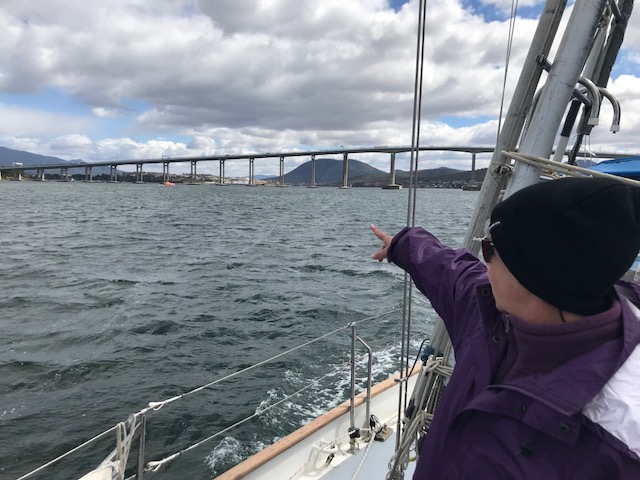
The wind was still pretty constant from the north west, but nothing like the day before. Due to the short distance to our re-fuelling stop at the Motor Yacht Club, we held off hoisting any sails, preferring to simply use the motor.
Close to the Lindisfarne Bay entrance we received a phone call from Peter Wright, who was standing on the club’s fuel dock, to inform us that the two spots at the fuel dock were already taken and suggesting we “hover” for 30 minutes or so until they were all done.
We were in no hurry – this was to be a relaxing jaunt after all – so we hoisted the jib and pottered across to Cornelian Bay to look at the moored yachts and the “beach sheds” that line the water’s edge.
Back at the fuel dock it seemed it was rush-hour, because a couple more boats came in after the first two, making for a more protracted “hover”. Finally, Peter suggested we enter the bay and marina precinct so as to be ready to come in as soon as a space became available. This worked a treat, assisted by a yacht that agreed to let us go before them; the very same boat, as it turned out, that we shared an anchorage with a week earlier in Stinking Bay near Port Arthur. That said, I don’t think they were aware that we’d been waiting , and effectively in the queue, for over an hour at that point.


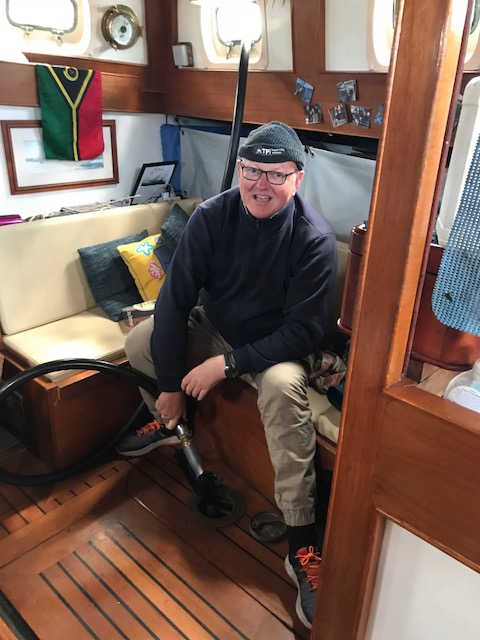
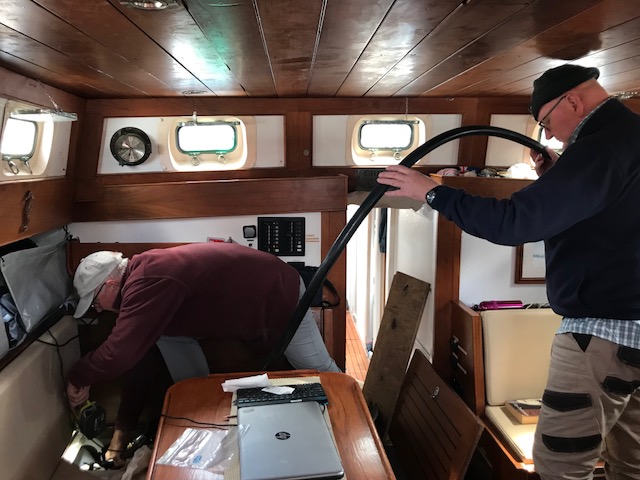
I should mention that whilst we were having afternoon tea with Peter and Gigi yesterday, we were taken down to the nearby Motor Yacht Club and Peter kindly showed us through the beautifully maintained and restored classic motor launch, ML Egeria, known as the “Governor’s Launch”. This is another one of the “maritime” groups Peter volunteers at, with this beautiful 1940s Huon Pine and Teak vessel being available for all sorts of private and public functions. As the website says, the ML Egeria is “… a unique part of the River Derwent heritage …”
https://www.motoryachtclub.org/functions-dining/ml-egeria


Same as before, but with Peter on the left and Linda taking the photo this time.

In the end, all went to plan and we loaded up with about 730 litres, which is roughly half our capacity, with an 8 cent/litre discount on account of Peter’s club membership.
After filling the tanks we made our way down past the Hobart-city, making sure to cruise in close-by to get a good view of the tall ships still at the dock and see more of the downtown area
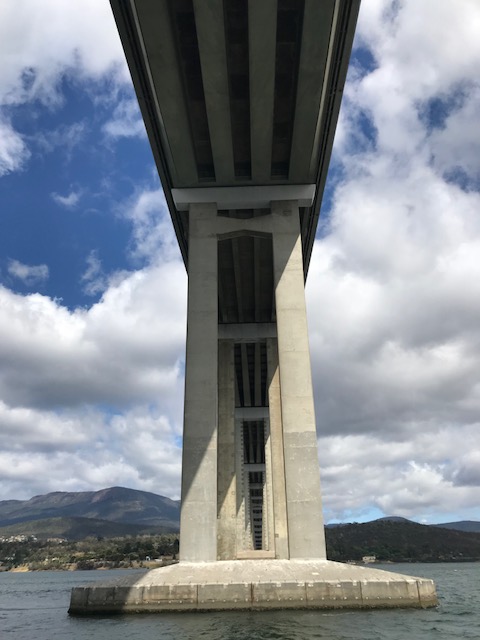




Being sheltered, the wind was variable and instead of coming from the north-west it was now coming from the south-west, the picturesque folding blue hills and the 1,200 metre Mount Wellington, framing the backdrop to an otherwise watery scene.
Leaving the Derwent and rounding the Iron Pot lighthouse, we made our way east across the top of Storm Bay, keeping Betsey Island to our port and the tip of the Tasman Peninsular and Frederick Henry Bay on the bow.
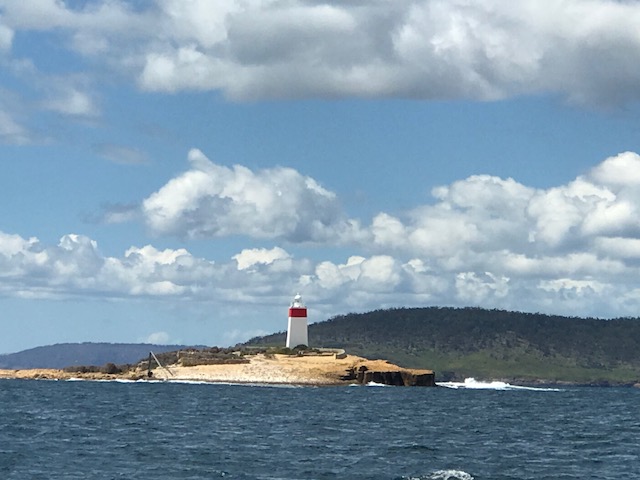


The wind was now a constant 20-25 knots from the west to north west – from behind – which made for a comfortable ride.
It was mostly sunny, with occasional rain squalls visible on the horizon, the colours of land, sea and sky making for a memorable picture in all directions.
Lunch was finally prepared and consisted of ham and salad sandwiches – the big decision being, do we have a late lunch, or do we wait until dinner, given we’d be dropping anchor in just a few hours. In the end, hunger got the better of us and we ate ravenously



As the afternoon wore on, the final decision was made about the night’s anchorage. Having made good time, we decided to travel slightly further down the coast from Plunkett Point, closer to Turner’s Point. The wind was still strong at around 20-25 knots, but offshore, and with very flat seas it might have been breezy on deck, but down below it was still as a billiard table.


Having heard so much about the fishing in these parts, we were eager to test it out. And so after having purchased some hooks and plastic baits at Big W yesterday I set about dropping a line in the water. I waited and waited, but nothing. “If I was a fish, I wouldn’t be tempted by bits of plastic shaped like worms and sardines, even if I was starving” … I observed. “Do we have any ham in the fridge, or meat of any kind. Real food?” I called down to the galley.
“Fish don’t eat ham!” came the natural response. “Yeh, but their going to eat ham before they eat plastic!”


So it was that I won the bet. Fish DO indeed eat ham. And once I’d caught my first fish, which took about as long as it took for the (stainless steel bolt) sinker to hit the 4 metre bottom, I discovered they eat each other too. In the end, I caught three legal-sized flathead, with the other fifteen or more baby flathead thrown back. I even caught two sharks (or maybe it was the same one twice) … which sounds impressive until you see the picture. They were as cute as a shark can get. All of 12 inches long, but eagre to use their mouths on anything that came close. To quote Murray, who’d borrowed the line from the film Finding Nemo … “I never knew my father …”



In the end I gave up on fishing because I got sick of throwing the little ones back, but we’d definitely cracked the fishing thing … all you had to do was attach a hook to a line with something tasty on the end, then throw it in the water… simples.
Dinner was kindly provided by Mark’s wife Denise, who sent an extremely tasty, pre-prepared spag-bol. And I think there was still some of Linda’s banana cake – made earlier in the day using one-and-half near-death, black-skinned bananas.
Late at night, although I think it was more like 2 in the morning, Linda – who sleeps on her “princess bed” in the cockpit was woken by a flapping tarpaulin on the aft-deck as a result of the wind getting up. Rather than wake everyone, and I’m paraphrasing her words and actions the next day, she …”bravely fought the fabric down, corner by corner, securing it with lines and lashings inch by inch, while still the forces of nature did their best to resist. And I was dressed only in my nightie, and did it singlehanded with my bare hands …” I think that pretty much sums it up, but as a bonus, the moon had set and Linda got to see the amazing phosphorescence on the surface of the sea all around as the ripples glowed and sparkled.
So ended another eventful day. Tomorrow we would be going ashore to discover the historic convict coal mine … the first in Tasmania … and look for ourselves at the World Heritage Listed, sandstone and brick penal settlement buildings from the 1830s. Or at least what was left of them
Smooth seas, fair breeze and Out to Sea Again
Rob
Latimer